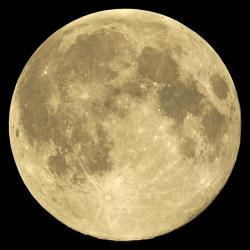For many years I have paid attention to moon phases and solunar tables. In a tournament I always try to be on my best spot when the Solunar tables say it is a prime feeding time. I have the Solunar Tables App on my I-Phone and check it before going fishing. Maybe it just gives me a little more confidence, but I think it helps.
Fishing the Moon
By Frank Sargeant
from The Fishing Wire
Expert saltwater anglers can tell you the day of every new and full moon in every month of the year, because they depend so much on the big tides that are generated for three days on either side of these strong lunar periods to create lots of current and cause a feeding binge among species like sea trout, redfish and snook.
The full moon–as well as the new moon–can trigger fish spawning activity in freshwater lakes just as both phases do in saltwater, with the spring phases a particularly good time to go fishing. Credit Wikimedia Commons.The strong moon phases make the high tides higher and the low tides lower, and moving that much water in and out of the estuaries naturally creates lots of tide flow, which pushes the bait around and makes it easy for gamefish to feed, which is why tide tables are so important to coastal anglers.
Freshwater anglers, not so much, but many of us could probably catch more fish more often if we paid closer attention to the big cheese-head in the sky.
Biologists say there’s definitely a surge in spawning activities for many species, including largemouth bass, crappies, bluegills and shellcrackers, on the strong moon periods. They just don’t come in the same months.
Why the pull of the moon seems to affect freshwater fish when there are no noticeable tides in fresh water is hard to figure, but some think it’s a leftover from the days when all fish were saltwater denizens.
The last strong moon period in March is likely to create the first largemouth spawn of the year in North Alabama, provided we get at least a seasonal warm-up. That warm-up now appears likely, and the new moon this month will fall on the 20th. This moon is also prime time for crappies, which will be stacked up around docks and brushpiles all over the TVA lakes as well as at Weiss and other impoundments.
The full moon in April is pretty much a no-brainer–bass are likely to be everywhere in the shallows, no matter what the weather, and there will be another push, often just as big, on the new moon. This year, the April full moon is the 4th, the new moon the 18th–good days to call in sick to work, for sure, if you’re a dedicated trophy bass angler. The fish spawn at depths anywhere from 12 inches to 6 or 8 feet in most of our lakes, frequently choosing spots around docks or other structure where their fry can hide.
A few leftover bass might still be spawning by the full moon on May 4, but by then most of the shallows will have been taken over by bluegills and shellcrackers, which spawn in the shallow bays, frequently on gravel or shell bottom. The May new moon, equally good, is the 18th.
And June can also be prime time for these panfish, though the early full moon on the 3rd is likely to be better than the new on the 16th. However, another player shows up in the shallows in June, and that is the gizzard shad–millions of them swarm into the warm bays to spawn. While anglers don’t fish for this species, they attract some very large bass ready to prey on the easy pickings, so locating an area where the shad are spawning can be key to catching some big largemouths. Shad-like swimbaits are the preferred offering, but spinnerbaits also work well.
Not to say plenty of fish of all these species won’t be caught during the weaker moon phases in spring–the fish are in the shallows, and anytime you can go fishing may be good. But if you can hit the strong phases, you just about assure yourself of good action.
